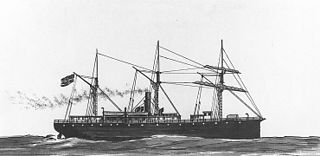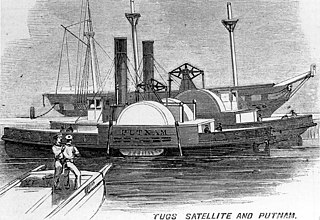
CSSEllis was a gunboat in the Confederate States Navy and the United States Navy during the American Civil War. It was lost during a raid while under command of famed Navy officer Lieutenant William B. Cushing.

The third USS Montgomery was a wooden screw steamer in the Union Navy during the American Civil War.

USS South Carolina was a steamer used by the Union Navy during the American Civil War.

The first USS Monticello was a wooden screw-steamer in the Union Navy during the American Civil War. She was named for the home of Thomas Jefferson. She was briefly named Star in May 1861.

USS Albatross was a screw steamer rigged as a three-masted schooner acquired by the Union Navy during the beginning of the American Civil War. She was outfitted as a gunboat with heavy guns and used in the Union blockade of the waterways of the Confederate States of America.

USSWhitehead, a screw steamer built in 1861 at New Brunswick, New Jersey, served as a gunboat in the United States Navy during the American Civil War.

The Battle of Elizabeth City of the American Civil War was fought in the immediate aftermath of the Battle of Roanoke Island. It took place on 10 February 1862, on the Pasquotank River near Elizabeth City, North Carolina. The participants were vessels of the U.S. Navy's North Atlantic Blockading Squadron, opposed by vessels of the Confederate Navy's Mosquito Fleet; the latter were supported by a shore-based battery of four guns at Cobb's Point, near the southeastern border of the town. The battle was a part of the campaign in North Carolina that was led by Major General Ambrose E. Burnside and known as the Burnside Expedition. The result was a Union victory, with Elizabeth City and its nearby waters in their possession, and the Confederate fleet captured, sunk, or dispersed.

USS Unadilla was a Unadilla-class gunboat built for service with the United States Navy during the American Civil War. She was the lead ship in her class.

USS Valley City was a 190-ton steamer acquired by the Union Navy for service in the American Civil War.
USS Whitehall was a steamer acquired by the Union Navy during the American Civil War. She was assigned blockade duty; however, her condition was not always considered seaworthy, and she was plagued with condition problems.

USS General Putnam – also known as the USS William G. Putnam – was acquired by the Union Navy during the first year of the American Civil War and outfitted as a gunboat and assigned to the Union blockade of the Confederate States of America. She also served as a tugboat and as a ship's tender when so required.

USS Hetzel was a steamer acquired by the Union Navy during the American Civil War. She was used by the Navy to patrol navigable waterways of the Confederacy to prevent the South from trading with other countries.
USS Isaac N. Seymour, also referred to variously as Seymour, I. N. Seymour and J. N. Seymour, was a steamer acquired by the Union Navy for use as a gunboat during the American Civil War. She was used by the Navy as a littoral ship in fire support, supply and blockading roles.

CSS Fanny was a small propeller-driven steam tug used by the Confederate States Navy to defend the sounds of northeastern North Carolina in the American Civil War. Originally armed as a gunboat and operated by the Union, she was captured in October 1861 by the Confederate Navy, and later lost at the Battle of Elizabeth City in February 1862. Due to being used as an observation balloon platform, Fanny is sometimes credited with being the first self-propelled aircraft carrier.
USS Corwin was a steamer acquired by the Union Navy during the American Civil War. She was used by the Union Navy to patrol navigable waterways of the Confederacy to prevent the South from trading with other countries.

USS Tahoma was a Unadilla-class gunboat built by order of the United States Navy for service during the American Civil War.
USS Henry Brinker was a small steamship acquired by the Union Navy during the American Civil War. She was placed into service as a gunboat and assigned to the blockade of ports of the Confederate States of America.
The third USS Union was a heavy (1,114-ton) steamer with a powerful 12-inch rifled gun purchased by the United States Navy during the American Civil War.

John Cummings Howell was an officer in the United States Navy during the American Civil War. He rose to the rank of rear admiral and late in his career was commander-in-chief of the North Atlantic Squadron and then of the European Squadron.
USS Isilda, sometimes spelled Ezilda, was an armed schooner in commission in the United States Navy from 1861 to 1863. As part of the Union Navy, she saw service during the American Civil War.















